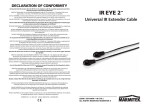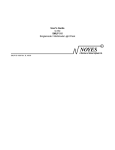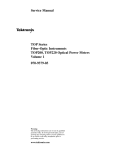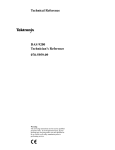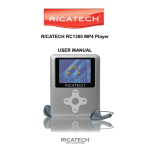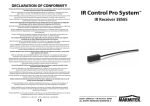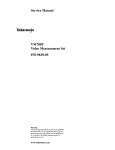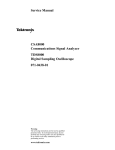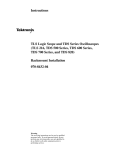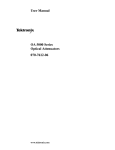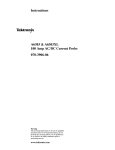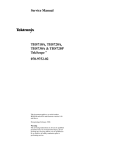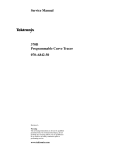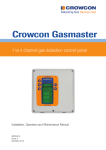Download User Manual SD-42 & SD-46 Optical to Electrical Converter Heads
Transcript
User Manual SD-42 & SD-46 Optical to Electrical Converter Heads 070-8671-01 Copyright E Tektronix, Inc. 1992. All rights reserved. Tektronix products are covered by U.S. and foreign patents, issued and pending. Information in this publication supercedes that in all previously published material. Specifications and price change privileges reserved. Printed in the U.S.A. Tektronix, Inc., P.O. Box 1000, Wilsonville, OR 97070–1000 TEKTRONIX and TEK are registered trademarks of Tektronix, Inc. WARRANTY Tektronix warrants that the products that it manufactures and sells will be free from defects in materials and workmanship for a period of one (1) year from the date of shipment. If a product proves defective during this warranty period, Tektronix, at its option, either will repair the defective product without charge for parts and labor, or will provide a replacement in exchange for the defective product. In order to obtain service under this warranty, Customer must notify Tektronix of the defect before the expiration of the warranty period and make suitable arrangements for the performance of service. Customer shall be responsible for packaging and shipping the defective product to the service center designated by Tektronix, with shipping charges prepaid. Tektronix shall pay for the return of the product to Customer if the shipment is to a location within the country in which the Tektronix service center is located. Customer shall be responsible for paying all shipping charges, duties, taxes, and any other charges for products returned to any other locations. This warranty shall not apply to any defect, failure or damage caused by improper use or improper or inadequate maintenance and care. Tektronix shall not be obligated to furnish service under this warranty a) to repair damage resulting from attempts by personnel other than Tektronix representatives to install, repair or service the product; b) to repair damage resulting from improper use or connection to incompatible equipment; c) to repair any damage or malfunction caused by the use of non-Tektronix supplies; or d) to service a product that has been modified or integrated with other products when the effect of such modification or integration increases the time or difficulty of servicing the product. THIS WARRANTY IS GIVEN BY TEKTRONIX IN LIEU OF ANY OTHER WARRANTIES, EXPRESS OR IMPLIED. TEKTRONIX AND ITS VENDORS DISCLAIM ANY IMPLIED WARRANTIES OF MERCHANTABILITY OR FITNESS FOR A PARTICULAR PURPOSE. TEKTRONIX’ RESPONSIBILITY TO REPAIR OR REPLACE DEFECTIVE PRODUCTS IS THE SOLE AND EXCLUSIVE REMEDY PROVIDED TO THE CUSTOMER FOR BREACH OF THIS WARRANTY. TEKTRONIX AND ITS VENDORS WILL NOT BE LIABLE FOR ANY INDIRECT, SPECIAL, INCIDENTAL, OR CONSEQUENTIAL DAMAGES IRRESPECTIVE OF WHETHER TEKTRONIX OR THE VENDOR HAS ADVANCE NOTICE OF THE POSSIBILITY OF SUCH DAMAGES. Table of Contents List of Figures . . . . . . . . . . . . . . . . . . . . . . . . . . . . . . . . . . . . . . . . . . . . . List of Tables . . . . . . . . . . . . . . . . . . . . . . . . . . . . . . . . . . . . . . . . . . . . . . General Safety Summary . . . . . . . . . . . . . . . . . . . . . . . . . . . . . . . . . . . . ii ii iii Connector Care . . . . . . . . . . . . . . . . . . . . . . . . . . . . . . . . . . . . . . . . . . . . . . . . . . . Installation . . . . . . . . . . . . . . . . . . . . . . . . . . . . . . . . . . . . . . . . . . . . . . . . . . . . . . 1–2 1–3 Connecting Signals . . . . . . . . . . . . . . . . . . . . . . . . . . . . . . . . . . . . . . . . . . . . . . . . Mean Power Monitor . . . . . . . . . . . . . . . . . . . . . . . . . . . . . . . . . . . . . . . . . . . . . . Buttons and Lights . . . . . . . . . . . . . . . . . . . . . . . . . . . . . . . . . . . . . . . . . . . . . . . . Calibration . . . . . . . . . . . . . . . . . . . . . . . . . . . . . . . . . . . . . . . . . . . . . . . . . . . . . . 2–1 2–2 2–2 2–2 Performance Check . . . . . . . . . . . . . . . . . . . . . . . . . . . . . . . . . . . . . . . . . 3–1 Using This Procedure . . . . . . . . . . . . . . . . . . . . . . . . . . . . . . . . . . . . . . . . . . . . . . Conventions . . . . . . . . . . . . . . . . . . . . . . . . . . . . . . . . . . . . . . . . . . . . . . . . . Initialized and Stored Settings . . . . . . . . . . . . . . . . . . . . . . . . . . . . . . . . . . . Menu Selections and Measurement Techniques . . . . . . . . . . . . . . . . . . . . . . Limits and Tolerances . . . . . . . . . . . . . . . . . . . . . . . . . . . . . . . . . . . . . . . . . . Preparation . . . . . . . . . . . . . . . . . . . . . . . . . . . . . . . . . . . . . . . . . . . . . . . . . . Optical Power Monitor Check . . . . . . . . . . . . . . . . . . . . . . . . . . . . . . . . . . . . . . . Pulse Amplitude and Pulse Width Check . . . . . . . . . . . . . . . . . . . . . . . . . . . 3–2 3–2 3–2 3–2 3–2 3–2 3–3 3–4 Appendix A: Accessories . . . . . . . . . . . . . . . . . . . . . . . . . . . . . . . . . . . . . A–1 Standard Accessories . . . . . . . . . . . . . . . . . . . . . . . . . . . . . . . . . . . . . . . . . . . . . . Optional Accessories . . . . . . . . . . . . . . . . . . . . . . . . . . . . . . . . . . . . . . . . . . . . . . A–1 A–1 Appendix B: Specifications . . . . . . . . . . . . . . . . . . . . . . . . . . . . . . . . . . . B–1 SD-42 Characteristics . . . . . . . . . . . . . . . . . . . . . . . . . . . . . . . . . . . . . . . . . . . . . . SD-46 Characteristics . . . . . . . . . . . . . . . . . . . . . . . . . . . . . . . . . . . . . . . . . . . . . . B–1 B–3 Appendix C: Replaceable Parts . . . . . . . . . . . . . . . . . . . . . . . . . . . . . . . C–1 Parts Ordering Information . . . . . . . . . . . . . . . . . . . . . . . . . . . . . . . . . . . . . . . . . Using the Replaceable Parts List . . . . . . . . . . . . . . . . . . . . . . . . . . . . . . . . . . . . . C–1 C–2 Getting Started Operating Basics Reference Appendices Index SD-42 & SD-46 User Manual i Table of Contents List of Figures Figure 1–1: Sampling Head Compartments in a CSA 803 Communications Signal Analyzer . . . . . . . . . . . . . . . . . . . . . . . . . . Figure 2–1: SD-42 Front Panel . . . . . . . . . . . . . . . . . . . . . . . . . . . . . . . . Figure 3–1: Setup to Check Optical Power Monitor Operation . . . . . Figure 3–2: Setup to Check Pulse Width and Pulse Amplitude . . . . . Figure B–1: SD-42 Frequency Response Curve . . . . . . . . . . . . . . . . . . Figure B–2: SD-42 Responsivity vs. Wavelength Curve . . . . . . . . . . . Figure B–3: SD-46 Frequency Response Curve . . . . . . . . . . . . . . . . . . Figure B–4: SD-46 Responsivity vs. Wavelength Curve . . . . . . . . . . . Figure C–1: Replaceable Mechanical Parts . . . . . . . . . . . . . . . . . . . . . 1–3 2–1 3–3 3–4 B–5 B–5 B–6 B–6 C–4 List of Tables Table 3–1: Test Equipment Required . . . . . . . . . . . . . . . . . . . . . . . . . . Table B–1: SD-42 Optical-to-Electrical Converter Head Pulse Characteristics . . . . . . . . . . . . . . . . . . . . . . . . . . . . . . . . . . . . . . . . . Table B–2: SD-42 Optical-to-Electrical Converter Head Power Meter Characteristics . . . . . . . . . . . . . . . . . . . . . . . . . . . . . . . . . . . . . . . . . Table B–3: SD-42 Optical-to-Electrical Converter Head Environmental and Mechanical Characteristics . . . . . . . . . . . . . . . . . . . . . . . . . . . Table B–4: SD-46 Optical-to-Electrical Converter Head Pulse Characteristics . . . . . . . . . . . . . . . . . . . . . . . . . . . . . . . . . . . . . . . . . Table B–5: SD-46 Optical-to-Electrical Converter Head Power Meter Characteristics . . . . . . . . . . . . . . . . . . . . . . . . . . . . . . . . . . . . . . . . . Table B–6: SD-46 Optical-to-Electrical Converter Head Environmental and Mechanical Characteristics . . . . . . . . . . . . . . . . . . . . . . . . . . . ii 3–1 B–1 B–1 B–2 B–3 B–3 B–4 SD-42 & SD-46 User Manual General Safety Summary Review the following safety precautions to avoid injury and prevent damage to this product or any products connected to it. Only qualified personnel should perform service procedures. While using this product, you may need to access other parts of the system. Read the General Safety Summary in other system manuals for warnings and cautions related to operating the system. Injury Precautions Ground the Product Do Not Operate in Explosive Atmosphere This product is indirectly grounded through the grounding conductor of the mainframe power cord. To avoid electric shock, the grounding conductor must be connected to earth ground. Before making connections to the input or output terminals of the product, ensure that the product is properly grounded. To avoid injury or fire hazard, do not operate this product in an explosive atmosphere. Safety Terms and Symbols Terms in This Manual These terms may appear in this manual: WARNING. Warning statements identify conditions or practices that could result in injury or loss of life. CAUTION. Caution statements identify conditions or practices that could result in damage to this product or other property. Terms on the Product These terms may appear on the product: DANGER indicates an injury hazard immediately accessible as you read the marking. SD-42 & SD-46 User Manual iii General Safety Summary WARNING indicates an injury hazard not immediately accessible as you read the marking. CAUTION indicates a hazard to property including the product. Symbols on the Product The following symbols may appear on the product: DANGER High Voltage iv Protective Ground (Earth) Terminal ATTENTION Refer to Manual Double Insulated SD-42 & SD-46 User Manual Getting Started Getting Started The SD-42 Optical-to-Electrical Converter Head and SD-46 Optical-to-Electrical Converter Head are high-performance optical heads for use in the 11800 Series Digital Sampling Oscilloscopes (including the SM-11 Multi-channel Unit) and the CSA 803 Communications Signal Analyzer. The SD-42/SD-46 Optical-toElectrical Converter Heads are used with SD-22, SD-24, and SD-26 Sampling Heads. The SD-42/SD-46 converts an optical signal into an electrical signal which serves as the input to an SD Series Sampling Head. The SD-42 Optical-to-Electrical Converter Head provides the following features: H DC to 6.4 GHz optical bandwidth H ≤55 ps optical impulse response (FWHM) with the SD-24 and SD-26, ≤60 ps optical impulse response (FWHM) with the SD-22 H 1000 nm to 1700 nm Spectral Response H Mean Optical Power Monitor function The SD-46 Optical-to-Electrical Converter Head provides the following features: SD-42 & SD-46 User Manual H DC to 20 GHz optical bandwidth H ≤28.5 ps optical impulse response (FWHM) with the SD-24 and SD-26 H 1200 nm to 1650 nm Spectral Response H Mean Optical Power Monitor function 1–1 Getting Started Connector Care The front of the SD-42/SD-46 Optical-to-Electrical Converter Head has a precision 3.5 mm connector for attaching the optical head electrical signal output to the lower input connector of an adjacent SD-24 or SD-26. These are high-precision connectors with a higher mechanical tolerance than standard SMA connectors. Never attach a cable to a plug-connector if the cable has a worn or damaged connector — damage may result. Use extra care when attaching or removing a cable from the connectors. Turn only the nut, do not turn the cable. When attaching a cable to the Optical-toElectrical Converter Head, align the connectors carefully before turning the nut. Use light, finger pressure to make this initial connection. Then tighten the nut lightly with a wrench. For best repeatability and to prolong the life of connectors, use a torque wrench and tighten the connection to the range of 7–10 lb-in (79–112 N-cm). The front of the SD-42/SD-46 has a precision FC/PC optical connector receptacle. This is for attaching a fiber optic signal cable. This connector receptacle has a locating keyway. To ensure repeatable connections, it is important to align this keyway on the connector and connector receptacle before tightening the nut. The nut should be tightened with light, finger pressure only. The connector receptacle must be kept free of dirt and dust. The cover cap should be replaced whenever the unit is not in use or a fiber is not connected. 1–2 SD-42 & SD-46 User Manual Getting Started Installation The SD-42/SD-46 Optical-to-Electrical Converter Head fits into the front panel of an 11800 Series Digital Sampling Oscilloscope or a CSA 803 Communications Signal Analyzer. See Figure 1–1. The SD-42/SD-46 Optical-to-Electrical Converter Head converts optical signals to electrical signals to be sampled. At least one sampling head must be installed in the oscilloscope for the instrument to sample signals. For the converted output signal from the SD-42/SD-46 to be sampled, the output of the SD-42/SD-46 must be connected to the input of an SD-24 or SD-26 Sampling Head (the SD-42 can also be connected to an SD-22). To accomplish this using the U-link provided with the SD-42/SD-46, the SD-24 or SD-26 must be in the plug-in slot immediately to the right of the slot occupied by the SD-46. The output of the SD-42/SD-46 is then connected to the lower input of the SD-24 or SD-26. To install a plug-in, first switch off the oscilloscope. Then place the plug-in in a compartment and slowly push it in with firm pressure. Once the plug-in is seated, turn the screw shaft on the plug-in to tighten the plug-in in place. Sampling Head Compartments SD-42/SD-46 SD-24/SD-26 Figure 1–1: Sampling Head Compartments in a CSA 803 Communications Signal Analyzer SD-42 & SD-46 User Manual 1–3 Getting Started 1–4 SD-42 & SD-46 User Manual Operating Basics Operating Basics The Figure 2–1 shows the front panel of the SD-42 Optical-to-Electrical Converter Head and identifies the button, lights, and connectors (the SD-46 is the same except for specification differences). The SD-42 has an FC/PC connector receptacle for optical signal input, a precision 3.5 mm connector for electrical signal output, two 2 mm sockets for mean power monitor output, a mean power monitor SELECT RANGE button, and two range/range overload indicator lights. Optical Signal Input Connector Screw Lock Knob Power Monitor Range Indicator Lights Electrical Signal Output Connector Power Monitor Range Select Button Power Monitor Output Sockets Figure 2–1: SD-42 Front Panel Connecting Signals The signal to be sampled must be coupled via a fiber optic cable (which must be a single-mode cable for calibrated response) terminated with an FC/PC style optical connector. This may be direct from the device-under-test/signal source or can be accomplished using optional cable accessories. A fiber terminated by an FC/PC style connector is connected to the FC/PC style input on the front of the SD-42/46. Care must be taken to ensure alignment of the key on the FC/PC connector with the keyway of the connector receptacle. SD-42 & SD-46 User Manual 2–1 Operating Basics Mean Power Monitor The SD-42/46 Mean Optical Power Monitor allows you to monitor the mean optical power coupled into the optical input using a digital voltmeter. The two 2 mm MONITOR sockets on the front of the SD-42/46 can be connected to most common digital voltmeters using the two 2 mm to 4 mm cables supplied with the SD-42/46. The monitor has two ranges, 1 V/mW and 1 V/mW (calibrated at 1300 nm for single-mode fibers) enabling mean optical input powers from 5 nW to 5 mW to be measured. NOTE. The signal output of the SD-42/46 must be connected to a sampling head or a 50 W terminator for the power monitor to function. Buttons and Lights The front panel of the SD-42/46 has a SELECT RANGE button and two range/range overload indicator lights. Pressing and releasing the SELECT RANGE button changes the range of the mean power monitor. The range indicator light glows green beneath the chosen range on the front panel, either 1 V/mW and 1 V/mW. If the mean optical input power is above the maximum for that range (that is, 5 mW for the 1 V/mW range or 5 mW for the 1 V/mW range) the green light will be replaced by a red range overload light. If the red light is illuminated while the monitor is in the 1 V/mW range, press the RANGE SELECT button to change the monitor to the 1 V/mW range. If the red light is illuminated in the 1 V/mW range, an optical attenuator should be fitted in the optical path before the converter. Under overload conditions, the output signal from the SD-42/46 may be degraded, and the mean power monitor reading will be meaningless. CAUTION. Under no circumstances should optical powers above 10 mW mean or 75 mW peak be applied to the input of the SD-42/46 Optical-to-Electrical Converter Head. Calibration The SD-42 Optical-to-Electrical Converter Head is calibrated for response to optical signals with wavelength of 1300 nm ±20 nm. Optical signals with wavelengths in the range of 1000 nm to 1700 nm can be analyzed using the SD-42 with the responsivity as a function of wavelength being given in 2–2 SD-42 & SD-46 User Manual Operating Basics Figure B–2. This responsivity curve is applicable to both the displayed waveform and the mean power monitor output. The SD-46 Optical-to-Electrical Converter Head is calibrated for response to optical signals with wavelength of 1300 nm ±20 nm. Optical signals with wavelengths in the range of 1200 nm to 1650 nm can be analyzed using the SD-46 with the responsivity as a function of wavelength being given in Figure B–4. This responsivity curve is applicable to both the displayed waveform and the mean power monitor output. SD-42 & SD-46 User Manual 2–3 Operating Basics 2–4 SD-42 & SD-46 User Manual Reference Performance Check Use the following procedure to check that your SD-42/SD-46 Optical-to-Electrical Converter Head is performing within specifications. Test Equipment Requirement Table 3–1 is a list of equipment required to accomplish the Incoming Inspection Procedure. Test equipment recommended is the minimum necessary to provide accurate results; therefore, substitute equipment must meet or exceed the specifications of the equipment listed. Detailed operating instructions for test equipment are not contained in this procedure. Should additional operating information be needed, refer to the appropriate test equipment instruction manual. Table 3–1: Test Equipment Required Item Description Performance Requirement Recommended Example Oscilloscope Tektronix Digital Sampling Oscilloscope Tektronix 11801A or CSA 803 Sampling Head Tektronix SD-22/SD-24/SD-26 Digital Multimeter Tektronix DM 504A Optical Impulse Generator 1300 nm wavelength, FWHM ≤30 ps, 60 ns pretrigger Tektronix OIG 502 Optical Attenuator Single mode, 1300 nm, 0–60 dB Tektronix OA 5002 Power Supply for OA 5002, OIG 502, and DM 504A CW Laser Source Tektronix TM5006 Power Module 1300 nm, FC/PC connections Power Supply for CW Laser Source Tektronix PS 503A Coaxial cable for pulse trigger, BNC connections Tektronix part number: 012–0482–00 Optical fiber cable Single mode, FC/PC connections Tektronix part number: 174–1387–00 BNC-SMA adapter SD-42 & SD-46 User Manual Tektronix ECL-to-Light Kit (part number 802–9249–06) using the LDM 1301 Laser Module from Photonic Packaging Technology Co. Tektronix part number: 015–1018–00 3–1 Performance Check Using This Procedure This procedure allows you to perform a basic optical inspection on the SD-42/SD-46 Optical-to-Electrical Converter Head with a minimum number of steps. Conventions In these procedures, the following conventions are used: H CAPITAL letters within the text identify front-panel controls, indicators, and connectors (for example, SELECT RANGE) on the plug-in heads and oscilloscope. H Bold letters identify menu labels and display messages. H Initial Capital letters identify connectors, controls, and indicators (for example, On) on associated test equipment. In some steps, the first word is italicized to identify a step that contains a performance verification and/or an adjustment instruction. For example, if Check is the first word in the title of a step, an electrical specification is checked. If Adjust appears in the title, the step involves an electrical adjustment. Initialized and Stored Settings At the beginning of most steps, the user is instructed to initialize the oscilloscope. The Initialize feature, located in the UTILITY major menu, presets all oscilloscope controls and functions, excluding the calibration constants, to default values. Initializing at the beginning of each part eliminates the possibility of settings from the previous parts causing erroneous or confusing results. Menu Selections and Measurement Techniques Details on measurement techniques and instructions for making menu selections are generally not included in this procedure. Comprehensive descriptions of menus and oscilloscope features are located in the oscilloscope User manual. Specific information on the SD Series Sampling Heads (SD-22/SD-24/SD-26) are located in the sampling head Installation/User manual. 3–2 Limits and Tolerances The limits and tolerances given in these procedures are for the Optical-to-Electrical Converter Head under test only. Test equipment error is not included except as noted. Preparation Before proceeding with the following checks, allow sufficient warm-up time for test equipment to stabilize (typically 20 minutes). The ambient temperature must be between 20_ C and 30_ C. SD-42 & SD-46 User Manual Performance Check Optical Power Monitor Check The Optical Power Monitor function of the SD-42/SD-46 does not use any of the oscilloscope functions. However the oscilloscope must be switched on and the electrical output of the SD-42/SD-46 must be terminated, preferably using the high-performance U-link connected to an adjacent SD-24/26. WARNING. Avoid eye exposure to the output of open-ended fibers/connectors. Ensure all fibers are terminated prior to turning on an optical source. 1. Connect the equipment as shown in Figure 3–1. SD-42/SD-46 SD-22/SD-26 Optical Input CSA 803 DVM Laser OA5002 Out In Out — + Rigid U-link Optical Cable Figure 3–1: Setup to Check Optical Power Monitor Operation 2. Switch on the CW laser source. 3. Set the digital voltmeter as follows: DC Volts Autoranging (or 200 mV) 4. On the SD-42/SD-46, using SELECT RANGE, set the range to 1 V/mW. 5. Adjust the optical attenuator until the digital multimeter reads 100 mV. There is now 100 mW of power incident on the SD-42/SD-46 input. 6. Increase the setting of the optical attenuator by 30 dB. SD-42 & SD-46 User Manual 3–3 Performance Check 7. On the SD-42/SD-46 use SELECT RANGE to select the1 V/mW range. 8. Check that the digital multimeter reads 100 mV ±20 mV, which is equivalent to 100 nW of optical input power. Pulse Amplitude and Pulse Width Check This procedure checks the pulse width and the pulse amplitude. WARNING. Avoid eye exposure to the output of open-ended fibers/connectors. Ensure all fibers are terminated prior to turning on an optical source. 1. Connect the equipment as shown in Figure 3–2. SD-42/SD-46 SD-22/SD-26 CSA 803 OIG 502 Pretrig Output Optical Output Rigid U-link Optical Input Trigger Optical Cable Figure 3–2: Setup to Check Pulse Width and Pulse Amplitude 2. Switch on the OIG 502. 3. Initialize the oscilloscope. 4. On the sampling head lower channel, press SELECT CHANNEL, so that the channel is ON. 5. Touch the vertical icon and adjust the Vert. Size to 100 mV/division. This setting is equivalent to 3.5 mW/division optical (100 mV/div × 35 mW/mV). 3–4 SD-42 & SD-46 User Manual Performance Check 6. Touch the horizontal icon and adjust the Main Size to 10 ns/division. The screen display shows a 100 ns window starting approximately 50 ns from the trigger edge. 7. Adjust the Main Pos. to position the pulse on the left-hand side of the screen. 8. Expand the Main Size to display the pulse. 9. Check that the displayed pulse width is <62 ps and the pulse amplitude is >200 mV peak. To take measurements from the displayed waveform, refer to the User Reference manual for the oscilloscope. SD-42 & SD-46 User Manual 3–5 Performance Check 3–6 SD-42 & SD-46 User Manual Appendices Appendix A: Accessories Some accessories are included with the SD-42/SD-46. If you wish to purchase optional accessories, or purchase additional standard accessories, see a Tektronix products catalog or contact your local Tektronix field representative. Standard Accessories H The SD-42 & SD-46 Optical to Electrical Converter Heads User Manual (Tektronix part number 070–8671–00) is this manual. H 50 W Semi-rigid “U” link, Tektronix part number 174–1635–00. H Red, 2 mm to banana lead, 1 m length, Tektronix part number 012–1286–00. H Black, 2 mm to banana lead, 1 m length, Tektronix part number 012–1287–00. Optional Accessories Optical Cables, Single Mode, 2 meter, 8/125 micron SD-42 & SD-46 User Manual H FC/PC to Diamond 2.5, Tektronix part number 174–1497–00. H FC/PC to Diamond 3.5, Tektronix part number 174–1385–00. H FC/PC to ST, Tektronix part number 174–1386–00. H FC/PC to FC/PC, Tektronix part number 174–1387–00. H FC/PC to Biconic, Tektronix part number 174–1388–00. A–1 Appendix A: Accessories A–2 SD-42 & SD-46 User Manual Appendix B: Specifications SD-42 Characteristics The following specifications apply at 25_ C ±5_ C; calibrated for use with a single-mode fiber input at 1300 nm. Table B–1: SD-42 Optical-to-Electrical Converter Head Pulse Characteristics Characteristic Performance Response Bandwidth DC – 6.4 GHz Wavelength Range 1000 to 1700 nm Optical Impulse Response Speed 55 ps max Full Width Half Maximum Conversion Factor 25 mW/V Conversion Gain 40 mV/mW Equivalent Display Noise with SD-22 10 mWRMS typical with SD-24/SD-26 33 mWRMS typical (unity dot response) <15 mWRMS typical (with smoothing) Aberrations (Step Response) <15% peak to peak in the first 400 ps following pulse input Linear Response Range <25 mW peak power <5 mW mean power Maximum Nondestructive Input 75 mW peak power 10 mW mean power Table B–2: SD-42 Optical-to-Electrical Converter Head Power Meter Characteristics Characteristic Performance Dynamic Range 5 nW to 5 mW Linear Response Range SD-42 & SD-46 User Manual Range 1 <5 mW mean, <25 mW peak Range 2 <5 mW mean, <25 mW peak B–1 Appendix B: Specifications Table B–2: SD-42 Optical-to-Electrical Converter Head Power Meter Characteristics (Cont.) Characteristic Performance Sensitivity Range 1 1 V/mW Range 2 1 V/mW Table B–3: SD-42 Optical-to-Electrical Converter Head Environmental and Mechanical Characteristics Characteristic Performance Weight 205 g (0.45 lbm) Height 71 mm (2.9 inches) Width 23 mm (0.95 inch) Depth 95 mm (3.9 inches) Ambient Temperature Operating 0_ C to 50_ C (32_ F to 122_ F) Nonoperating –55_ C to +75_ C (–67_ F to +167_ F) Altitude B–2 Operating to 4.5 km (15,000 ft.) Nonoperating to 15 km (50,000 ft.) Humidity to 95% relative humidity at up to 50_ C (122_ F) Electromagnetic Compatibility Meets FCC Part 15J Class B SD-42 & SD-46 User Manual Appendix B: Specifications SD-46 Characteristics The following specifications apply at 25_ C ±5_ C; calibrated for use with a single-mode fiber input at 1300 nm. Table B–4: SD-46 Optical-to-Electrical Converter Head Pulse Characteristics Characteristic Performance Response Bandwidth DC – 20 GHz Wavelength Range 1200 to 1650 nm Optical Pulse Response Speed 22 ps max Full Width Half Maximum Conversion Factor 35 mW/V Conversion Gain 29 mV/mW Equivalent Display Noise with SD-22 ≤16 mWRMS typical with SD-24/SD-26 ≤46 mWRMS typical Aberrations <10% peak to peak in the first 400 ps following pulse input Linear Response Range ≤25 mW peak power ≤5 mW mean power Maximum Operating Input 25 mW peak power 5 mW average power Table B–5: SD-46 Optical-to-Electrical Converter Head Power Meter Characteristics Characteristic Performance Dynamic Range 5 nW to 5 mW Linear Response Range Range 1 <5 mW mean, <25 mW peak Range 2 <5 mW mean, <25 mW peak Sensitivity SD-42 & SD-46 User Manual Range 1 1 V/mW Range 2 1 V/mW B–3 Appendix B: Specifications Table B–6: SD-46 Optical-to-Electrical Converter Head Environmental and Mechanical Characteristics Characteristic Performance Weight 205 g (0.45 lbm) Height 71 mm (2.9 inches) Width 23 mm (0.95 inch) Depth 95 mm (3.9 inches) Ambient Temperature Operating 0_ C to 50_ C (32_ F to 122_ F) Nonoperating –55_ C to +75_ C (–67_ F to +167_ F) Altitude B–4 Operating to 4.5 km (15,000 ft.) Nonoperating to 15 km (50,000 ft.) Humidity to 95% relative humidity at up to 50_ C (122_ F) Electromagnetic Compatibility Meets FCC Part 15J Class B SD-42 & SD-46 User Manual Appendix B: Specifications Figure B–1: SD-42 Frequency Response Curve Figure B–2: SD-42 Responsivity vs. Wavelength Curve SD-42 & SD-46 User Manual B–5 Appendix B: Specifications Figure B–3: SD-46 Frequency Response Curve Figure B–4: SD-46 Responsivity vs. Wavelength Curve B–6 SD-42 & SD-46 User Manual Appendix C: Replaceable Parts This section contains a list of the components that are replaceable for the SD-42/SD-46 Optical-to-Electrical Converter Heads. Use this list to identify and order replacement parts. Parts Ordering Information Replacement parts are available through your local Tektronix field office or representative. Changes to Tektronix products are sometimes made to accommodate improved components as they become available and to give you the benefit of the latest improvements. Therefore, when ordering parts, it is important to include the following information in your order. H Part number (see Part Number Revision Level below) H Instrument type or model number H Instrument serial number H Instrument modification number, if applicable If you order a part that has been replaced with a different or improved part, your local Tektronix field office or representative will contact you concerning any change in part number. Change information, if any, is located at the rear of this manual. Part Number Revision Level Tektronix part numbers contain two digits that show the revision level of the part. For most parts in this manual, you will find the letters XX in place of the revision level number. Part Number Revision Level 670-7918-03 Revision Level May Show as XX 670-7918-XX When you order parts, Tektronix will provide you with the most current part for your product type, serial number, and modification (if applicable). At the time of your order, Tektronix will determine the part number revision level needed for your product, based on the information you provide. SD-42 & SD-46 User Manual C–1 Appendix C: Replaceable Parts Module Servicing Modules can be serviced by selecting one of the following three options. Contact your local Tektronix service center or representative for repair assistance. Module Exchange. In some cases you may exchange your module for a remanufactured module. These modules cost significantly less than new modules and meet the same factory specifications. For more information about the module exchange program, call 1-800-TEK-WIDE, extension 6630. Module Repair and Return. You may ship your module to us for repair, after which we will return it to you. New Modules. You may purchase replacement modules in the same way as other replacement parts. Using the Replaceable Parts List This section contains a list of the mechanical and/or electrical components that are replaceable for the <instrument>. Use this list to identify and order replacement parts. The following table describes each column in the parts list. Parts List Column Descriptions Column Column Name Description 1 Figure & Index Number Items in this section are referenced by figure and index numbers to the exploded view illustrations that follow. 2 Tektronix Part Number Use this part number when ordering replacement parts from Tektronix. 3 and 4 Serial Number Column three indicates the serial number at which the part was first effective. Column four indicates the serial number at which the part was discontinued. No entries indicates the part is good for all serial numbers. 5 Qty This indicates the quantity of parts used. 6 Name & Description An item name is separated from the description by a colon (:). Because of space limitations, an item name may sometimes appear as incomplete. Use the U.S. Federal Catalog handbook H6-1 for further item name identification. 7 Mfr. Code This indicates the code of the actual manufacturer of the part. 8 Mfr. Part Number This indicates the actual manufacturer’s or vendor’s part number. Abbreviations Mfr. Code to Manufacturer Cross Index C–2 Abbreviations conform to American National Standard ANSI Y1.1–1972. The table titled Manufacturers Cross Index shows codes, names, and addresses of manufacturers or vendors of components listed in the parts list. SD-42 & SD-46 User Manual Appendix C: Replaceable Parts Manufacturers Cross Index Mfr. Code Manufacturer Address City, State, Zip Code TK0392 NORTHWEST FASTENER SALES INC 7923 SW CIRRUS DRIVE BEAVERTON OR 97005–6448 TK0435 LEWIS SCREW CO 4300 S RACINE AVE CHICAGO IL 60609–3320 TK1163 POLYCAST INC 9898 SW TIGARD ST TIGARD OR 97223 00261 GENERAL ELECTRIC CO FOOD SERVICE EQUIPMENT BUSINESS DEPT 14TH AND ARNOLD STS CHICAGO HEIGHTS IL 60411 80009 TEKTRONIX INC 14150 SW KARL BRAUN DR PO BOX 500 BEAVERTON OR 97077–0001 Replaceable Parts List Fig. & Index Number Tektronix Part Number A-5-1 Serial No. Effective Serial No. Discont’d Qty Name & Description Mfr. Code Mfr. Part Number 366–0673–00 1 KNOB:O.096 ID X 0.24 OD X 0.299H TK1163 ORDER BY DESC –2 211–0087–01 5 SCREW,MACHINE:2–56 X 0.188,FLH,82 DEG,STL TK0435 ORDER BY DESC –3 200–3658–00 1 COVER,CONNECTOR:FC,W/CHAIN 80009 200365800 –4 211–0405–00 1 SCREW,MACHINE:2–56 X 0.375,TRH,SST TK0392 TO BE ASSIGNED –5 210–1171–00 2 WASHER,SHLDR:0.12 ID X 0.143 OD X 0.07 D 00261 A7148516P2 STANDARD ACCESSORIES 012–1286–00 1 CABLE,INTCON:1ML,2MM JACK TO BANANA,RED 80009 012128600 012–1287–00 1 CABLE,INTCON:1ML,2MM JACK TO BANANA,BLK 80009 012128700 174–1635–00 1 CABLE ASSY,RF:50 OHM COAX,80.0MM L 80009 174163500 070–8671–00 1 MANUAL,TECH:USER,SD42/SD46 80009 070867100 174–1385–00 1 CA ASSY,FBR OPT:SGL MODE,2M L (FC/PC TO DIAMOND 3.5) 80009 174138500 174–1386–00 1 CA ASSY,FBR OPT:SINGLE MODE,2M L (FC/PC TO ST) 80009 174138600 174–1387–00 1 CA ASSY,FBR OPT:SGL MODE,2M L (FC/PC TO FC/PC) 80009 174138700 174–1388–00 1 CA ASSY,FBR OPT:SGL MODE,2M L (FC/PC TO BICONIC) 80009 174138800 174–1497–00 1 CA ASSY,FBR OPT:SINGLE MODE,2M L (FC/PC TO DIAMOND 2.5) 80009 174149700 OPTIONAL ACCESSORIES SD-42 & SD-46 User Manual C–3 Appendix C: Replaceable Parts Figure C–1: Replaceable Mechanical Parts C–4 SD-42 & SD-46 User Manual Index Index A O accessories optional, A–1 standard, A–1 attaching cables, 1–2 attaching connectors, 2–1 optical input connector, 2–1 optical response, 2–2, 2–3 B buttons, 2–2 SELECT RANGE, 2–2 C cables, attaching, 1–2 connector care, 1–2 connectors, attaching, 2–1 P performance check, 3–1–3–5 limits and tolerances, 3–2 optical power monitor, 3–3 pulse amplitude and pulse width, 3–4 test equipment required, 3–1 power monitor, 2–2 R replaceable parts, C–9 response, optical, 2–2, 2–3 F S features SD-42, 1–1 SD-46, 1–1 front panel, 2–1, 2–2 SD-46, specifications, B–5–B–6, B–8 SD-42, specifications, B–3–B–4, B–7 SELECT RANGE button, 2–2 signal, input, 2–1 Specifications SD-46, B–5–B–6, B–8 SD-42, B–3–B–4, B–7 I input connector, 2–1 installation, 1–3 M T Test equipment, 3–1 mean power monitor, 2–2 MONITOR sockets, 2–2 SD-42 & SD-46 User Manual Index–1 Index Index–2 SD-42 & SD-46 User Manual















































